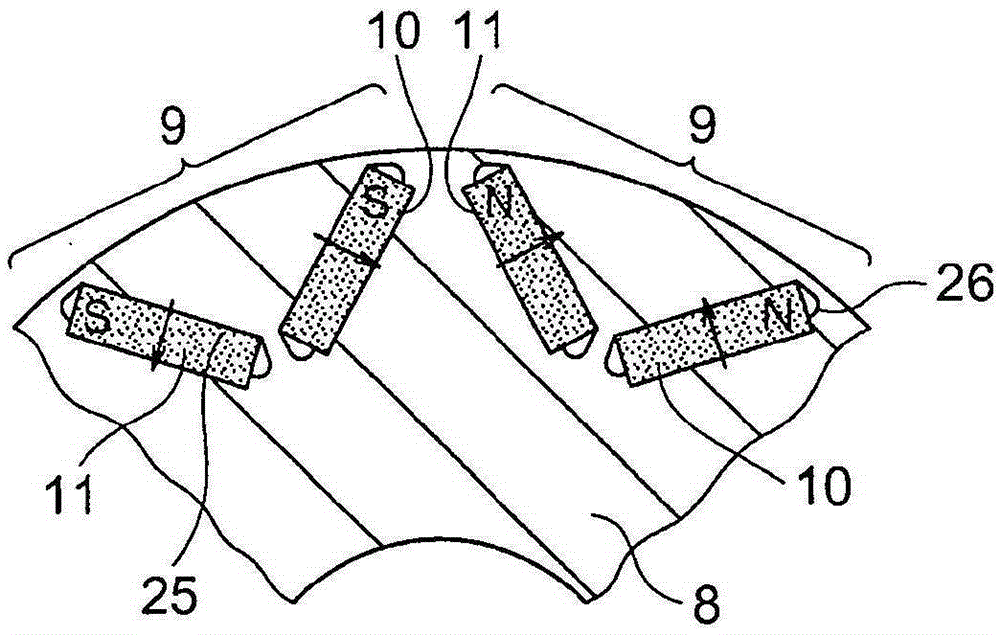Rotating electric machine
A technology for rotating electrical machines and rotors, applied to synchronous motors with stationary armatures and rotating magnets, electric components, electrical components, etc., can solve the problems of unpredictable permanent magnet temperature, etc., and achieve the goal of suppressing demagnetization and reducing temperature distribution Effect
- Summary
- Abstract
- Description
- Claims
- Application Information
AI Technical Summary
Problems solved by technology
Method used
Image
Examples
Embodiment approach 1
[0032] figure 1 is a front cross-sectional view showing a main part of a motor as a rotating electrical machine according to Embodiment 1 of the present invention, figure 2 yes means figure 1 An enlarged view of the main parts of the motor.
[0033] This motor includes a stator 1 and a rotor 2. The stator 1 has a stator core 3 and stator coils (not shown) wound in slots 6. The stator core 3 has 12 slots 6 through which Teeth 5 extending radially inward from the annular core back 4 are formed at intervals in the circumferential direction, and the rotor 2 is rotatably disposed coaxially with the stator core 3 on the stator. 1 on the inner peripheral side.
[0034] The stator core 3 is formed by laminating thin steel plates.
[0035] The stator coil is composed of three-phase windings (U phase, V phase, W phase) wound on teeth 5. One end of the wire of each phase winding is connected to the converter side, and the other end of the wire is used as a neutral wire to connect wi...
Embodiment approach 2
[0074] Figure 9 It is a front cross-sectional view showing a main part of a motor according to Embodiment 2 of the present invention.
[0075] In this embodiment, the rotor 2 has a rotor core 8 and a plurality of rectangular permanent magnets 18 per pole, and the plurality of permanent magnets 18 are embedded in the rotor core 8 at intervals in the circumferential direction. the outer peripheral side.
[0076] A plurality of magnet housing holes 25 extending in the axial direction and housing the permanent magnets 18 are formed in the rotor core 8 formed by laminating thin steel plates. The permanent magnets 18 housed in the respective magnet housing holes 25 are arranged such that a perpendicular bisector of the permanent magnets 18 passes through the axis of the rotor 2 .
[0077] The permanent magnet 18 has N poles and S poles alternately set along the circumferential direction.
[0078] In addition, gaps 26 are formed at both ends of the magnet housing hole 25 , and th...
Embodiment approach 3
[0094] Figure 13 It is a front cross-sectional view showing a main part of a motor according to Embodiment 3 of the present invention.
[0095] The rotor 2 has: a rotating shaft 7; a rotor core 8 fixed to the rotating shaft 7 by press-fitting, shrink-fitting, or keys; The outer peripheral side of the magnet is composed of three rectangular-shaped first permanent magnets 30 , second permanent magnets 31 and third permanent magnets 32 per pole.
[0096]A plurality of magnet housing holes 25 extending in the axial direction and housing the first permanent magnet 30 , the second permanent magnet 31 and the third permanent magnet 32 are formed in the rotor core 8 formed by laminating thin steel plate layers. The first permanent magnet 30 and the third permanent magnet 32 located on both sides of the second permanent magnet 31 face each other so that the distance between them in the circumferential direction increases in the radially outer direction.
[0097] Such as Figure...
PUM
 Login to View More
Login to View More Abstract
Description
Claims
Application Information
 Login to View More
Login to View More - Generate Ideas
- Intellectual Property
- Life Sciences
- Materials
- Tech Scout
- Unparalleled Data Quality
- Higher Quality Content
- 60% Fewer Hallucinations
Browse by: Latest US Patents, China's latest patents, Technical Efficacy Thesaurus, Application Domain, Technology Topic, Popular Technical Reports.
© 2025 PatSnap. All rights reserved.Legal|Privacy policy|Modern Slavery Act Transparency Statement|Sitemap|About US| Contact US: help@patsnap.com



